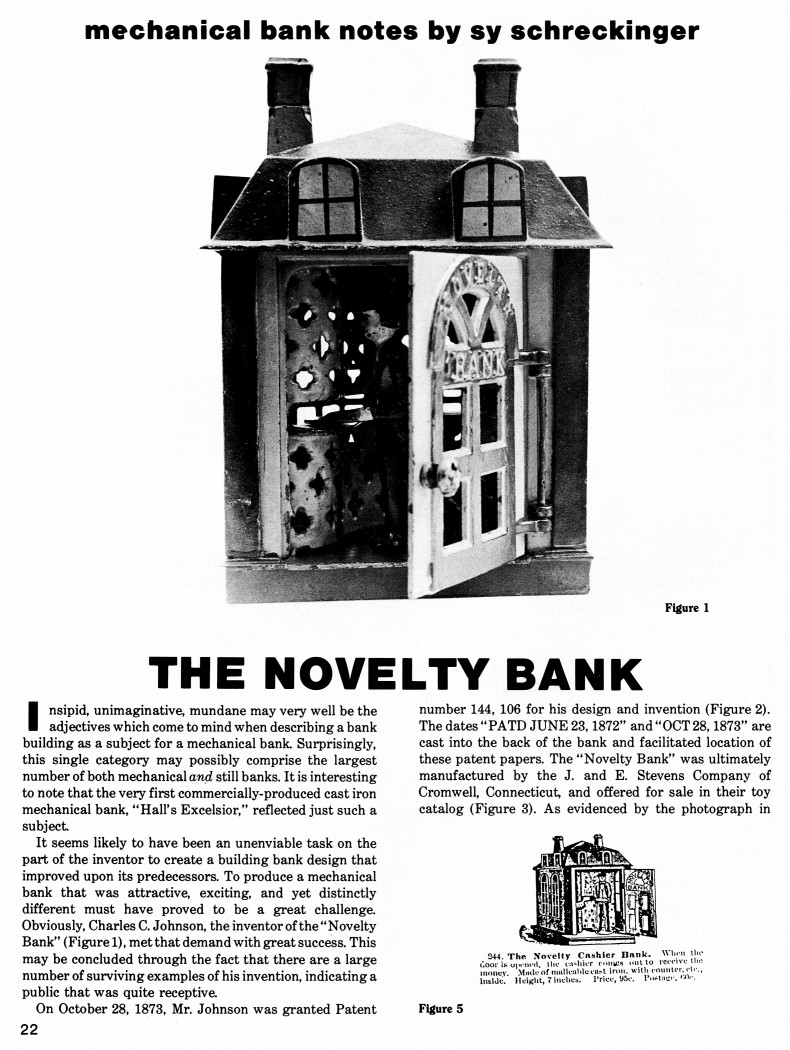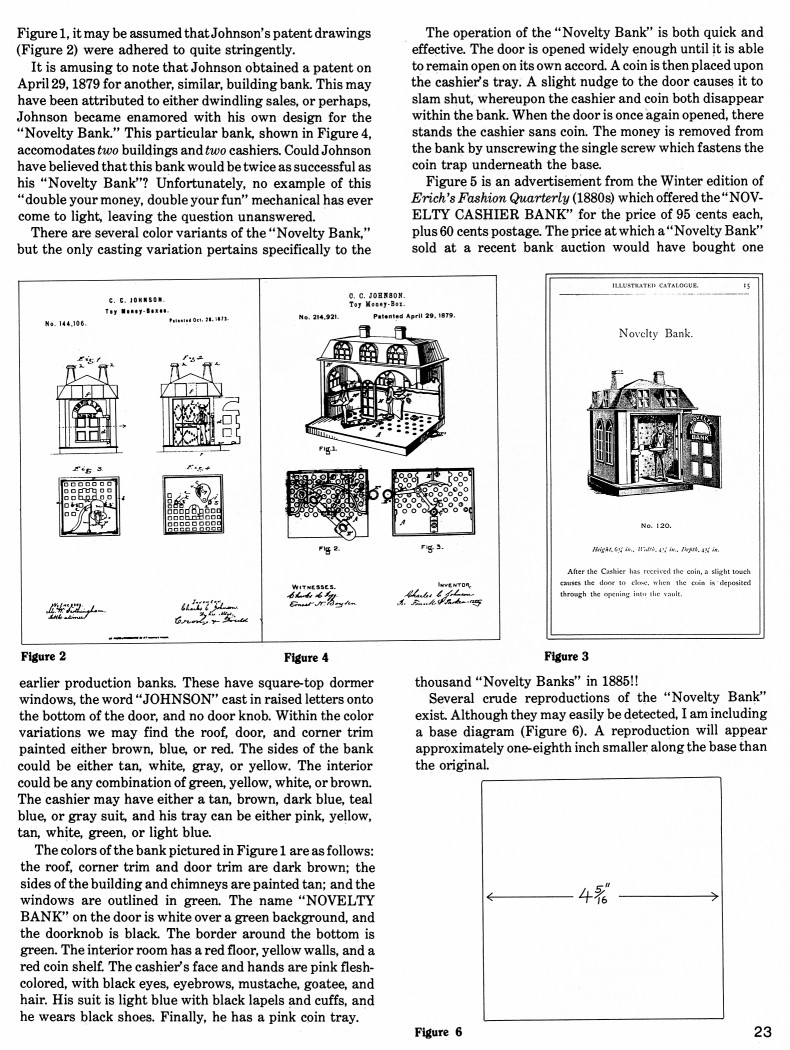|
The Novelty Bank
by Sy Schreckinger – ANTIQUE TOY WORLD Magazine – February,
1987
Insipid,
unimaginative, mundane may very well be the adjectives which come to mind
when describing a bank building as a subject for a mechanical bank.
Surprisingly, this single category may possibly comprise the largest
number of both mechanical and still banks. It is interesting to note that
the very first commercially-produced cast iron mechanical bank, "Hall's
Excelsior," reflected just such a subject.
It seems likely to have been an unenviable task on the part of the
inventor to create a building bank design that improved upon its
predecessors. To produce a mechanical bank that was attractive, exciting,
and yet distinctly different must have proved to be a great challenge.
Obviously, Charles C. Johnson, the inventor of the "Novelty Bank" (Figure
1), met that demand with great success. This may be concluded through the
fact that there are a large number of surviving examples of his invention,
indicating a public that was quite receptive.
On October 28, 1873, Mr. Johnson was granted Patent number
144,106
for his design and invention (Figure 2). The dates "PATD JUNE 23, 1872"
and "OCT 28, 1873" are cast into the back of the bank and facilitated
location of these patent papers. The "Novelty Bank" was ultimately
manufactured by the J. and E. Stevens Company of Cromwell, Connecticut,
and offered for sale in their toy catalog (Figure 3). As evidenced by the
photograph in Figure 1, it may be assumed that Johnson's patent drawings
(Figure 2) were adhered to quite stringently.
It is amusing to note that Johnson obtained a patent on
April 29,1879
for another, similar, building bank. This may have been attributed to
either dwindling sales, or perhaps, Johnson became enamored with his own
design for the "Novelty Bank." This particular bank, shown in Figure 4,
accommodates two buildings and two cashiers. Could Johnson have believed
that this bank would be twice as successful as his "Novelty Bank"?
Unfortunately, no example of this "double your money, double your fun"
mechanical has ever come to light, leaving the question unanswered.
There are several color variants of the "Novelty Bank," but the only
casting variation pertains specifically to the earlier production banks.
These have square-top dormer windows, the word "JOHNSON" cast in raised
letters onto the bottom of the door, and no door knob. Within the color
variations we may find the roof, door, and corner trim painted either
brown, blue, or red. The sides of the bank could be either tan, white,
gray, or yellow. The interior could be any combination of green, yellow,
white, or brown. The cashier may have either a tan, brown, dark blue, teal
blue, or gray suit, and his tray can be either pink, yellow, tan, white,
green, or light blue.
The colors of the bank pictured in Figure 1 are as follows: the roof,
corner trim and door trim are dark brown; the sides of the building and
chimneys are painted tan; and the windows are outlined in green. The name
"NOVELTY BANK" on the door is white over a green background, and the
doorknob is black. The border around the bottom is green. The interior
room has a red floor, yellow walls, and a red coin shelf. The cashier's
face and hands are pink flesh-colored, with black eyes, eyebrows,
mustache, goatee, and hair. His suit is light blue with black lapels and
cuffs, and he wears black shoes. Finally, he has a pink coin tray.
The operation of the "Novelty Bank" is both quick and effective. The
door is opened widely enough until it is able to remain open on its own
accord. A coin is then placed upon the cashier's tray. A slight nudge to
the door causes it to slam shut, whereupon the cashier and coin both
disappear within the bank. When the door is once again opened, there
stands the cashier sans coin. The money is removed from the bank by
unscrewing the single screw which fastens the coin trap underneath the
base.
Figure 5 is an advertisement from the Winter edition of Erich's
Fashion Quarterly (1880s) which offered the "NOVELTY CASHIER BANK" for the
price of 95 cents each, plus 60 cents postage. The price at which a
"Novelty Bank" sold at a recent bank auction would have bought one
thousand "Novelty Banks" in 1885!!
Several crude reproductions of the "Novelty Bank" exist. Although
they may easily be detected, I am including a base diagram (Figure 6). A
reproduction will appear approximately one-eighth inch smaller along the
base than the original.
|


